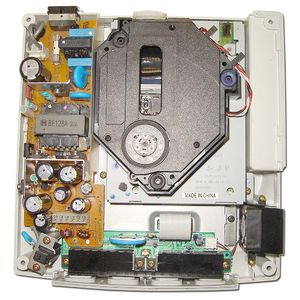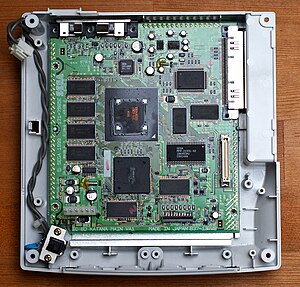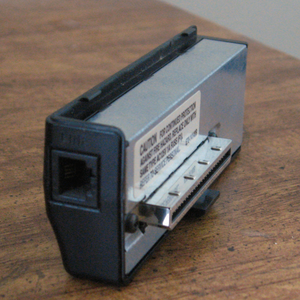Dreamcast
The Sega Dreamcast (Dreamcast) was a sixth generation video game console produced by SEGA, it would become their final console before exiting the hardware industry. The Dreamcast was the successor to the Sega Saturn, which had limited success in sales in both Japan and in the United States. It was released sixteen months before the PlayStation 2 (PS2) and three years before the Nintendo GameCube and the Xbox, and widely hailed as ahead of its time. The Dreamcast was seen as a milestone for pioneering online console gaming.[1]
The Dreamcast was officially discontinued by Sega in 2001, however the console's following is still maintained by occasional game releases from Japan and the homebrew community. By the end of its lifespan, the console sold over 10 million units breaking various sales records set by past consoles. [2]
History
Development
Development of the Dreamcast, codenamed "Katana" began shortly after the release of the SEGA Saturn.
In May 1998 it was revealed that Microsoft's Windows CE operating system would power the device. Upon launch the OS was absent from the console, SEGA revealed the OS ships on the disc giving developers the opportunity to ship their games with the latest version of the OS. SEGA provided their own in-house alternative to Windows CE for developers to use. [3]
The Dreamcast launched in North America on September 9, 1999 and Europe on October 14, 1999.
Launch
The Dreamcast initially launched in Japan on November 27, 1998, it is reported that shortly before launch pre-orders for the system in Japan exceeded 50,000 units. It was revealed that graphic chip shortages from manufactuerer NEC would lead to supply shortages at launch, SEGA originally expected the console to sell 1 million units in Japan by the end of March 1999 and an additional 10 million units over the next three to four years. [4]
Technical specifications
Processor
- SH-4 RISC CPU with 32-bit Instruction Set and 128-bit FPU functions (operating frequency: 200 MHz, 360 MIPS, 1.4 GFLOPS)
Graphics Engine
- CLX2, 7.0 Mil polygons/second peak performance, supports Trilinear filtering. Actual maximum in game performance (with full textures, lighting, gameplay, etc.) of over 5 Mil polygons/second.
- Tile Based Deferred Rendering eliminates overdraw by only drawing visible fragments. This makes required fillrate almost independent from scene depth complexity, thus making up for a low, compared to other 6th generation consoles, nominal fillrate of 100 MPixels/s as effective fillrate can be triple that amount.
- Graphics hardware effects include gouraud shading, z-buffering, anti-aliasing and bump mapping.
Memory
- Main RAM: 16 MB[5] 64 Bit 100 MHz
- Video RAM: 8 MB 4x16 Bit 100 MHz
- Sound RAM: 2 MB 16 Bit 66 MHz
- VQ Texture Compression (5:1 texture compression)[6]
Sound Engine
- Yamaha AICA Sound Processor: 22.5 MHz 32-Bit ARM7 RISC CPU: 45 MHz,[6] 64 channel PCM/ADPCM sampler (4:1 compression), XG MIDI support, 128 step DSP
Storage
- Yamaha GD-ROM Drive: 12x maximum speed (Constant Angular Velocity)
- GD-ROM: Holds up to 1.2 GB
- Visual Memory Unit ("VMU") 1 Mbit (128 KB[5]) removable storage device and 4x memory cards that hold four times as much data.
Input/Output
- Inputs: USB-like "Maple Bus". Four ports support devices such as digital and analog controllers, steering wheels, joysticks, keyboards, mice, and more.
- Color Output: Approx. 16.78 million colors (24-bit)
- Video resolution: 640x480 interlaced or progressive scan
Dimensions
- 189 mm × 195 mm × 76 mm (7 7/16in × 7 11/16in × 3in)
- Weight: 1.9 kg (4.2 lb)
- Color: Majority are white.
- Japan: Various limited edition designs and colored consoles were produced
- North America: Only a black "Sega Sports"-labeled model and a blue model from Electronics Boutique were officially available
- PAL: No known alternate designs or colors
Networking
- Modem: Removable; speed varied among regions:
- Original Asia/Japan model had a 33.6 kbit/s; consoles sold after September 9, 1999 had a 56 kbit/s modem
- All American models had a 56 kbit/s
- All PAL models had a 33.6 kbit/s
- Broadband: these adapters are available separately and replace the removable modem
- HIT-401 "Broadband Adapter", the more common model, this used a Realtek 8139 chip and supported 10 and 100 Mbit speeds, this device was released in Japan.
- HIT-400: "Broadband Adapter", the more common model, this used a Realtek 8139 chip and supported 10 and 100 Mbit speeds, this device was released in US.
- HIT-300: "Lan Adapter", this version used a Fujitsu MB86967 chip and supported only 10 Mbit speed.
Sales
During the Japanese launch of the Dreamcast SEGA sold 150,000 units despite chip shortages, by Feburary of the next year console sales were just under 900,000 units, SEGA originally expected the console would sell at least 1 million units in Japan by the end of March.[7] During the US launch of the system SEGA sold over 1 million consoles. [8]
Attribution
- Some content on this page may previously have appeared on Wikipedia.
References
- ↑ Dreamcast Connects Console Gamers. GameSpy (July 2003). Retrieved on 2007-07-19.
- ↑ The 10 Worst-Selling Consoles of All Time. Game Pro (July 19 2007). Retrieved on 2008-07-5.
- ↑ Windows CE notably absent from Dreamcast launch. CNET (1999-09-15). Retrieved on 2011-10-08.
- ↑ SEGA SAYS CHIP SHORTAGE COULD AFFECT DREAMCAST SALES.. Datamonitor (1998-11-). Retrieved on 2011-10-08.
- ↑ 5.0 5.1 In this article, the conventional prefixes for computer memory denote base-2 values whereby “kilobyte” (KB) = 210 bytes, “megabyte” (MB) = 220 bytes.
- ↑ 6.0 6.1 Sega Dreamcast Review Part 1. FiringSquad.com (1999-09-07). Retrieved on 2007-07-19.
- ↑ SEGA SAYS CHIP SHORTAGE COULD AFFECT DREAMCAST SALES.. Datamonitor (1998-11-). Retrieved on 2011-10-08.
- ↑ PlayStation2 shortage buoys up Sega. Japan Times (2000-12-27). Retrieved on 2011-10-08.


